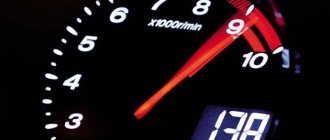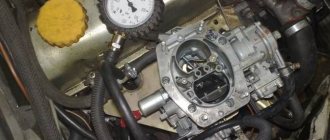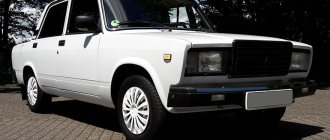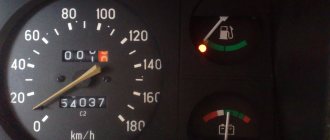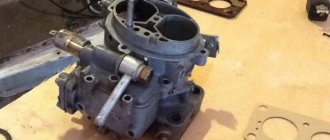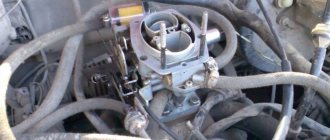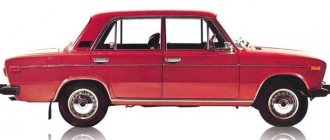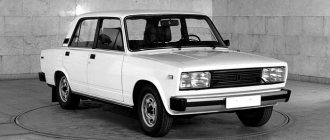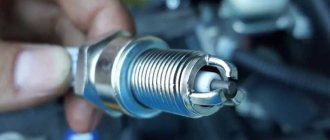A Soviet-made car, which was produced only as a station wagon. The basic version of the model is the VAZ 2102. Production began in 1984 and ceased only in 2012. The car has always been considered the cheapest station wagon of those sold in our markets. This is explained by the fact that the machine is created from the simplest parts and is easy to assemble.
What is the fuel consumption per 100 km of VAZ-2104
In Soviet times, car owners were not particularly concerned about the gluttony of their cars - except that the consumption indicators clearly exceeded the norm. Gasoline was quite cheap, so pouring another portion into the tank had virtually no effect on the family budget. Today the situation has changed, and for the worse. Accordingly, fuel consumption is currently one of the priorities, for example, when purchasing a new iron horse. At the same time, older car owners carefully monitor that fuel consumption does not exceed the norm. This fully applies to the VAZ “classics”. Many representatives of this family today can safely be called venerable old men (by automotive standards). Long service life in combination with design solutions of the 70-80s of the last century lead to the fact that the car becomes quite voracious. Accordingly, VAZ owners strive, if possible, to reduce this indicator. Practice has shown that it is quite possible to do this - the main thing is to know how.
First hybrid car | HowStuffWorks
The first hybrid car was not the Toyota Prius and was not invented in the 1990s or 2000s. In fact, it dates back to the early 20th century. However, the first hybrid car was created for reasons that will be familiar to those living in the early 21st century: internal combustion engines produced too much dirty pollution.
The first hybrid car was partly the brainchild of a Viennese bus builder named Jacob Lohner, who felt that gas-powered cars were too noisy and smelly. To find a solution to this problem, Lohner turned to a young Austrian engineer named Ferdinand Porsche. In 1896, when he was just 21 years old, Porsche invented the electric wheel hub motor, a battery-powered motor that actually fit into the wheel hub. Lohner asked Porsche to pair his in-wheel motors with one of Lohner's trainers. The result was the Lohner-Porsche Elektromobil. This car was first shown to the general public at the Paris Exhibition in 1900.
Even though the Elektromobil was originally a purely electric vehicle, it became the first hybrid in history. Faced with the problem of keeping the Elektromobil's batteries charged, Porsche added an internal combustion engine that ran on a generator, making the Elektromobil the first car to combine an electric motor with a gasoline engine. This gas-electric hybrid could reach a top speed of 38 mph (61.2 km/h). The first person to buy an Elektromobil was E. W. Hart of Luton, England, who asked Porsche to put motors on all four wheels. Porsche complied, and the Elektromobil became not only the first hybrid, but also a pioneering all-wheel drive car. The Elektromobil did not introduce the concept of green driving - in fact, by the time it debuted, there had been fully electric cars for several decades, but it did show how electricity and gasoline can be used together to improve fuel efficiency.
VAZ-2104 – what fuel consumption per 100 kilometers is considered normal
Naturally, speaking about the Quartet’s appetite, specific figures should be given.
First of all, it is worth recalling that this model was supplied to the market with different types of engines. Of course, their fuel consumption indicators are different. Generally speaking, during the period when the Quartet was produced, 3 types of engines were installed on it: However, the latter never became widespread. The cost of a car with a diesel engine was higher than with a gasoline engine, while in terms of power it was slightly, but still inferior to both carburetor and injection engines. As a result, not many of these cars came off the assembly line. The VAZ-2104 was equipped with a 4-cylinder, 8-valve, one and a half liter diesel engine. The power of this power plant is 50 horsepower. Motors of this type are characterized by low fuel consumption. The diesel engine installed on the VAZ-2104 was no exception to the rule.
The consumption figures pleased the owners - 6.7 and 5.8 liters in the city and on the highway, respectively. However, high initial costs have scared off many potential buyers.
Engines with carburetors have higher consumption rates, of course. The “fours” were equipped with 2 types of such power plants. The first is the VAZ-2103, 4-cylinder, 8-valve, 1.3 liter. The power of this engine is 63 horsepower. When driving on a city highway, this engine consumes 10 liters per hundred. On the highway, consumption is 6.9 liters.
Another carburetor engine installed on the “four” was the one and a half liter VAZ-2103 power plant. The 4-cylinder 8-valve engine in the city and on the highway consumed, respectively, 9.8 and 7 liters per 100 kilometers.
And finally, injection engines. Two models of such power plants were installed on the Quartet. One of them is VAZ-21073. A special feature of this 1.7-liter 4-cylinder, 8-valve engine is central fuel injection. With a power of 84 horsepower, this power plant consumed 9.5 liters in the city and 7.5 on the highway. However, there are different data on the latter indicator.
The VAZ-21067 engine with a volume of 1.6 liters was also installed on the Quartet. The 4-cylinder, 8-valve power unit with an output of 82 horsepower is quite voracious. In particular, in the city this modification consumes 11.3 liters. Agree, at current fuel prices it’s difficult to call such a car economical. When driving on a country highway, fuel consumption drops to 6.9 liters.
In conclusion, I would like to note one important point. Fuel consumption depends on many factors. Of course, the technical condition of the car plays an important role here. There are many breakdowns with which you can drive for a while, while the car’s appetite increases significantly. In order not to throw money away, you need to eliminate them as soon as possible. In addition, consumption directly depends on driving style. Sharp acceleration combined with active braking increases the vehicle's fuel consumption.
If you want to save money, then you need to give up this driving style. The driving style should be calm, with smooth acceleration and a minimum amount of braking, so that you do not have to pick up speed again. Otherwise, consumption on the “four” is unlikely to be less than 12 liters in the city.
Another important point is the time of year. Probably everyone knows that fuel consumption is higher in winter than in summer. Firstly, before driving off at sub-zero temperatures, it is recommended to warm up the car - and this means additional fuel consumption. Secondly, difficult weather conditions and slippery road surfaces force you to drive in lower gears, which, in turn, increases consumption.
Video: review of the “four” – Valve adjustment
The rich mixture may be due to the carburetor needle not holding the level, the float has a leak and has collected gasoline, the float level is incorrectly set, or the jets are incorrectly set to the calibers. The three-door VAZ 2108 will cause even more inconvenience; it can only be loaded through the rear door, while the 2109 allows you to use a pair of side doors.
| Model | 2104 | 21041 | 21043 | 21043-03 | 21044 | 21045 |
| Body type | station wagon | |||||
| Places | 5 | |||||
| Doors | 5 | |||||
| Trunk volume | 345/1035 | |||||
| Dimensions and weight of the car | ||||||
| Length | 4115 | |||||
| Width without mirrors | 1620 | |||||
| Height | 1443 | |||||
| Own weight | 1020 | |||||
| Payload | 455 | |||||
| Base | 2424 | |||||
| Front track | 1365 | |||||
| Rear track | 1321 | |||||
| Ground clearance to engine oil pan. | 182 | |||||
| Ground clearance to rear axle beam | 170 | |||||
| Ground clearance to the lane beam. pendants | 175 | |||||
| Device Features | ||||||
| Engine | 2105 | 2101 | 2103 | 2103 | VAZ-3411 | |
| Working volume, l | 1,294 | 1,198 | 1,452 | 1,452 | 1,452 | |
| Rated power at a crankshaft speed of 5600 min-1 according to GOST 14846 (net) | 47,0 (63,9) | 43,2 (58,7) | 52,3 (71,1) | 52,3 (71,1) | 38,7* (52,6) | |
| * At a crankshaft speed of 4800 min-1 | ||||||
| Compression ratio | 8,5 | 8,5 | 8,5 | 8,5 | 23 | |
| Tires | Chamber, radial 165/70 R13 or 165/80R13 (165SR13) | |||||
| Wheels | Disc, stamped | |||||
| Rim size | 127J-330(5J-13) | |||||
| Drive wheels | Rear | |||||
| Front suspension | Independent, wishbone, with coil springs, telescopic hydraulic shock absorbers and anti-roll bar | |||||
| Rear suspension | Five-rod. Dependent, rigid beam connected to the body by one transverse and four longitudinal rods, with coil springs and hydraulic shock absorbers | |||||
| Transmission | ||||||
| Clutch | Single disc, dry, with central pressure spring | |||||
| Transmission | Mechanical, three-way, four- or five-speed, with synchronizers on all forward gears | |||||
| Number of gear stages | 5 or 4 | |||||
| Gearbox ratios | ||||||
| I | 3,636 | |||||
| II | 1,95 | |||||
| III | 1,357 | |||||
| IV | 0,941 | |||||
| V | 0,784 | |||||
| Reverse | 3,53 | |||||
| Final drive ratio | 4,1 | 4,1 | 4.1 or 3.9 | 4.1 or 3.9 | 4.1 or 3.9 | 4.1 or 3.9 |
| Brakes | ||||||
| Front brakes | Disc with two opposing hydraulic cylinders and automatic restoration of the specified gap | |||||
| Rear brakes | Drum with self-centering shoes, with automatic restoration of the gap between the shoes and the drum, with a pressure regulator | |||||
| Service brake drive | Foot-operated, hydraulic, dual-circuit, with vacuum booster | |||||
| Parking brake drive | Cable | |||||
| Clutch drive | Hydraulic | |||||
| Steering | ||||||
| Steering | Trauma-proof, with intermediate cardan shaft | |||||
| Steering gearbox | With globoidal worm and double-ridge roller on ball bearings, gear ratio 16.4 | |||||
| Steering gear | Three-link, consists of one middle and two lateral symmetrical rods, bipod, pendulum and swing arms | |||||
| Electrical equipment | ||||||
| Electrical wiring system | Single-wire, the negative pole of the current sources is connected to ground. Nominal voltage, 12 V | |||||
| Accumulator battery | 6ST55P, capacity 55 Ah at 20-hour discharge mode | |||||
| Generator | 37.3701, AC with built-in rectifier and voltage regulator. Output current 55 A at 5000 min” | |||||
| Starter | 35.3708, with electromagnetic traction relay and freewheel, power 1.3 kW | |||||
| Spark plug | A17DV or FE 65 P with M14X1.25 thread | |||||
| Dynamic and operational characteristics | ||||||
| Maximum speed with driver and 1 passenger | ||||||
| Maximum speed with full load | 135 | 143 | 143 | |||
| Acceleration time to 100 with driver and 1 passenger | 18,5 | 17 | 17 | |||
| Acceleration time to 100 with full load | ||||||
| Smallest turning radius | 5,6 | |||||
| Maximum lift without acceleration, in% | 34 | |||||
| Braking distance of a loaded vehicle from 80 km/h | 43,2 | |||||
| Fuel consumption at 90 km/h | 7,5 | 7,4 | 7,4 | |||
| Fuel consumption at 120 km/h | 10,1 | 10,3 | 10,3 | |||
| Fuel consumption in the urban driving cycle | 10 | 10,3 | 10,3 | |||
| Fuel tank capacity | 42 | |||||
| Macca towable trailer with brakes | 600 | |||||
| Towed trailer weight without brakes | 300 | |||||
| Maximum roof rack weight | 50 |
Fuel consumption VAZ 2104
Show me how you drive and I'll tell you who you are
A Soviet-made car, which was produced only as a station wagon. The basic version of the model is the VAZ 2102. Production began in 1984 and ceased only in 2012. The car has always been considered the cheapest station wagon of those sold in our markets. This is explained by the fact that the machine is created from the simplest parts and is easy to assemble.
Official data (l/100 km)
| Engine | Consumption (city) | Consumption (highway) | Flow (mixed) |
| 1.3 MT 64 hp (Mechanics) | 10.1 | 5.8 | 7.4 |
| 1.5 MT 75 hp (Mechanics) | 10.3 | 7.4 | 9.0 |
| 1.6 MT 74 hp (Mechanics) | 9.5 | 6.9 | 9.2 |
| 1.7 MT 79 hp (Mechanics) | 9.5 | 7.2 | 8.3 |
| 1.5 MT 50 hp diesel (mechanics) | 5.7 | 5.8 | 5.8 |
Scheme for switching on headlights and fog lights
1 — block headlights; 2 — mounting block 2104; 3 — headlight switch in a three-lever switch; 4 — external lighting switch; 5 — rear fog light switch; 6 — rear lights; 7 - rear fog light circuit fuse; 8 — fog light indicator lamp, located in the indicator lamp block; 9 — indicator lamp for high beam headlights, located in the speedometer; 10 — ignition switch; P5 - headlight high beam relay; P6 - low beam headlight relay; A - view of the headlight plug connector: 1 - low beam plug; 2 — high beam plug; 3 — ground plug; 4 — side light plug; B - to terminal 30 of the generator; B — terminals of the rear light printed circuit board (numbering of terminals from the edge of the board): 1 — to ground; 2 — to the brake light lamp; 3 — to the side light lamp; 4 — to the fog light lamp; 5 — to the reversing light lamp; 6 - to the turn signal lamp.
VAZ 2104
The VAZ 2104 was equipped with several gasoline power plants. There was also a diesel version. The main engine that was equipped with the model had a volume of 1.3 liters, with a power reaching 64 horsepower. Fuel was supplied using a carburetor. Gasoline consumption for this version was 7.3 liters. The next setting is 1.5 liters. Here the power was 75 horses. The engine was also paired with a carburetor. This engine used up to 9 hp.
Another gasoline representative is 1.6 liters. Its peak power was 74 horsepower. This engine was paired with an injector. Fuel consumption per 100 km was at 9.2 liters. And the last engine that consumed gasoline was 1.7 liters. It developed up to 79 horsepower and consumed 8.4 liters of fuel. The diesel used a 1.5 liter engine. The maximum power that could be squeezed out of it was 50 hp, and it consumed 5.7 liters of fuel. All versions came with four-speed transmissions, which were only mechanical.
Owner reviews
“The car is well suited for my work as a courier. Absolutely all the goods that need to be transported fit. The car is well equipped and driving around the city is quite comfortable. Outwardly, of course, ugly, but this is not so important. But it is assembled with very high quality and is highly reliable. I hardly repair it, I just change consumables and carry out technical inspections on a timely basis. The engine, however, is rather weak. You can't really go on the highway; you can only use it normally in the city. And the high consumption is somehow not impressive. I spend about 12 liters,” writes Nikolai from Penza.
“A good car, but only for the city. I tried to take it on a trip to visit relatives in another city - I will never go again. There is no comfort at all, constantly in tension. You should never let go of the steering wheel, otherwise it will start to move to the sides. The motor is very weak. If in the city you can easily drive just by pressing the gas a little, then here I had to press it to the floor. You should also not drive off the road at all. There is no cross-country ability; you can even get stuck in a puddle. But most of all I was disappointed by the consumption, which reaches 14 liters in the city,” said Kirill from Perm.
“When my father bought himself a new car, I got this one. And now, for ten years now I have not parted with him. I studied all the pros and cons. The most important thing is to avoid long trips, as this is a real test. It doesn’t maintain speed, and if you load it up, the car barely moves at all. The interior is poorly made, the materials are cheap, and there are very few functions. Ideal for a car - quiet city driving. But even here there are drawbacks - fuel consumption, which in summer can be as much as 14 liters, and in winter – as much as 15,” wrote Oleg from Tyumen.
“My four are almost thirty years old. During this time there were practically no breakdowns, only various little things. All that was damaged was the body, which I successfully repaired. Otherwise the car remained almost like new. It’s stupid to compare its equipment with new models, but for everyday tasks you can’t think of anything better. There is a lot of space in it, it drives calmly, and it consumes little fuel. I don't spend more than 11 liters. In winter, of course, a little more - about 12, but still, when compared with our other cars, this value is quite modest,” the car from Leonid from Yakutsk received such results.
“I bought a four especially for work, because I don’t mind killing it. I use it to transport various materials to rather hard-to-reach places. And, oddly enough, the car was safe and sound, although I was worried that it wouldn’t last long. There is a lot of space in it, which is important to me, but it is poorly equipped, there is practically nothing in the cabin, and something is always creaking. There is no sound insulation at all. The engine is weak, but it is enough for a leisurely drive somewhere. It just eats up a fair amount of gasoline. My normal consumption is 13 liters,” this is Andrey’s review from Moscow.
“I bought the car just for the soul. I started tuning. I redid the interior, trimmed it with normal materials, and covered the seats in leather. Now I want to take care of the appearance and chassis. In the end I will replace the motor with something solid. But that’s when I’ve saved up some money. So the machine is quite good, but in current it is terribly not cozy and comfortable. And the engine drives slowly and consumes a lot of fuel,” said Nikita from Tula.
basic information
VAZ and UAZ cars are long-lived in the domestic automobile market. The four occupies a separate place among the frets - it is considered the cheapest station wagon. And the VAZ 2104’s gasoline consumption rate per 100 km has absolutely nothing to do with it – it’s a matter of design.
1.3 (64 hp, gasoline) 5-mech
1.5 (71 hp, gasoline) 5-mech
1.6 (74 hp, gasoline) 5-mech
1.6 (84 hp, gasoline) 5-mech
| Engine | Consumption (highway) | Consumption (city) | Consumption (mixed cycle) |
| 1.5 (53 hp petrol) 5-mech | 5.8 l/100 km | 8 l/100 km | 6.7 l/100 km |
| – | 7.5 l/100 km | – | |
| 7 l/100 km | 9.9 l/100 km | 9.2 l/100 km | |
| 6.9 l/100 km | 9.5 l/100 km | 9.2 l/100 km | |
| – | 9.5 l/100 km | – |
The technical characteristics of the car are standard and not as impressive as those of foreign cars. But for the brainchild of the Soviet, and subsequently the domestic automobile industry, the gasoline costs of the Lada 2104 in the city and with mixed driving are an achievement. The data of this model cannot but rejoice.
Chassis
The suspension here is completely identical to the “five”. So, the front has an independent suspension with hydraulic shock absorbers and transverse swing arms. There was a bridge at the back and there were rods (four longitudinal and one transverse). Brakes are discs at the front and drums at the rear. As reviews note, this car lacks brakes, especially if it is loaded with 200-300 kilograms. There are also complaints about the steering. The car has poor road holding and is not maneuverable.
Among the advantages of the suspension is its softness. However, this does not mean that you can safely “fly” through the pits. The suspension doesn't like sharp impacts. Because of this, the shock absorbers leak and the lower arms are deformed. Among the weak points of the Zhiguli suspension, it is worth noting the ball joints. These are supports and tips. They become unusable very quickly. Wheel bearings also have a short lifespan. Another drawback is the sound of the suspension. Even if the chassis is in good working order, various knocks can be heard inside. It's alarming at first, but you can get used to it.
Data Comparison
With a 1.5 engine, the four can reach a top speed of 145 km/h. Only gasoline should be filled into the fuel tank. The average consumption for 2104 is approximately 10 liters
, which on the one hand is quite a lot, and on the other hand is the norm for most cars, especially those produced domestically.
Fuel consumption of the VAZ 2104 per 100 km depends on several factors
, namely:
- depending on the time of year;
- from the driving cycle (urban, suburban and mixed);
- on driving style;
Fuel consumption on the VAZ 2104, a carburetor with minimal power, is contributed by the driving cycle. The fuel consumption of the VAZ 2104 on the highway is significantly less than in the city - 7 and 10 liters, respectively.
.
The actual fuel consumption on the injection VAZ 2104 depends on some nuances of the assembly of this car model, and can range from 7
up to 12 liters for urban driving, and 5-8 liters when driving on the highway.
Design features [edit | edit code]
Since the front part of the car is identical to models with a sedan body, it is more difficult for a standard heater to warm a larger volume of the interior during the cold season. The back of the car often fogs up in cold weather. The car normally does not have rear ventilation holes for venting interior air (unlike the VAZ-2107), which makes it difficult to close the doors (with the windows closed). Compared to the VAZ-2105, 2107 (with identical engine installations), it has a lower maximum speed (data from the “operating instructions”
142 km/h) due to the changed final drive ratio - 4.44 (early modifications) versus 4.3 on the sedan. The rear door is subject to contamination by road dirt (dust raised by wheels), which is locally drawn when driving at high speeds into the low-pressure zone - this is corrected by installing an upper deflector on the 5th door, supplying (to the low-pressure zone) cleaner air from the roof. There is also a way to avoid the accumulation of dirt on the back door - this is to change the design of the rear bumper - the lower part must be bent in the opposite direction and the gap between the bumper and the body must be closed - a plate 1 meter by 15 cm in the middle. The gas tank with a volume of 43 liters (versus 39) is located horizontally under the bottom of the trunk without additional protection - there is a risk of damage when driving over rough terrain.
How to reduce fuel consumption
In order not to constantly pour a large amount of fuel into the VAZ fuel tank, you should follow a few simple rules
:
- you should adhere to a more restrained driving style without sudden braking and sudden starts;
- in the cold season, leave your four in warmer rooms - this will help you spend less time warming up the engine and, accordingly, reduce fuel costs;
- use only high-quality fuel;
- Monitor the general condition of your car and promptly replace outdated or worn parts.
Such small tricks will help reduce the fuel consumption of the VAZ 2104 to a minimum.
Price
This is perhaps the most affordable station wagon available on the secondary market. The cost of the “four” is from 20 to 60 thousand rubles. The mileage of all cars is different, but since the odometer is only calculated up to 100 thousand, it is difficult to find out the exact mileage. And since it is predominantly a workhorse, it is more difficult to find a “four” in good condition than the same “seven” or “five”.
Gasoline consumption data for the VAZ 2104. Tips for reducing fuel consumption
The VAZ 2104 car was developed by Soviet engineers for the broadest masses of the population, the main tasks that were set for the developers were the ease of assembly and repair of the car, as well as the maximum cost reduction in its manufacture and maintenance. They began producing cars back in 1984, their production continued until 2012, during which time the engine was modernized several times, the body concept remained unchanged, this is a station wagon with five doors, with a spacious luggage compartment. As for the fuel consumption of the VAZ 2104, depending on the engine size, its design and the quality of the road, the car consumes from 6 to 10 liters of gasoline or about 6 liters of diesel fuel.
Types of VAZ 2104 engines
Since the start of production, the car has undergone several modifications, and they mainly concerned engine configurations. The first samples were supplied with a base power unit with a volume of 1.3 liters, and the power of such an engine was equal to 64 horsepower. These engines were of the carburetor type, and the 1984 model consumed an average of 7.3 liters. per hundred kilometers of combined cycle traffic.
One of the branches of the series can be called the VAZ 21043, its fuel consumption per 100 km did not differ from the basic version of the car, but there were noticeable changes in the amount of on-board electronics, and instead of the standard 4-speed manual, a 5-speed transmission system was installed .
Carburetor engines
Initially, such power units were installed on all cars in this series; in total, there were two types of engines, in which fuel injection was carried out through a carburetor:
- VAZ 2103 - the volume of this engine was 1.5 liters, with a power of 75 hp. Fuel consumption with this carburetor engine is 7 liters. on the highway and 9.9 l. in urban and mixed traffic cycles. The engine is equipped with 4 cylinders and 8 valves.
- VAZ 2105 - 64-horsepower engine, with a volume of 1.3 liters. Its factory consumption rate is 6.9 liters. on the highway, 9.2 l. with mixed traffic and up to 10 liters. within the city limits. The 2105 engine also has 4 cylinders and 8 valves.
Injection engines
- VAZ 21067 - distributed injection of gasoline into the cylinders made it possible to significantly reduce fuel consumption on the VAZ 2104 car, to 6.9 liters. on the highway, 8.5 l. with a mixed driving cycle, but in the city fuel consumption increased to 11.3 liters, this is due to an increase in the volume of the engine compartment to 1.6 liters.
- VAZ 21073 is the most powerful engine with an injector installed on one of the modifications of the VAZ 2104 car, with a fuel compartment volume of 1.7 liters. However, this version in urban driving consumed gasoline per 100 km less than its brothers in the workshop up to 9.5 liters.
History [edit | edit code]
Serial production of the VAZ-2104
(“fours”) was launched at the Volzhsky Automobile Plant in the second half of 1984. In parallel with the new model, a similar class car, the VAZ-2102 (“two”), was produced, which by April 1985 was completely forced out of the assembly line. The “four” received a number of original parts relating to the rear of the car from the “donor” car.
When creating this model, the designers were guided by an important feature of that time: the creation of a new model with minimal production costs and maximum consumer effect. Therefore, the VAZ-2105 model was taken as a basis. After lengthening the roof, stampings appeared to increase rigidity. This body design allows you to place a long trunk on the roof, which is not recommended to be overloaded, since the design rigidity of the station wagon body is significantly lower than that of a sedan. The rear door opened upwards, and a completely new solution was used - a heated rear window and a windshield wiper - which until 1994 was used only in the production of cars for export, and then became standard.
At the end of the 1990s, an “improved” modification of the VAZ-21043-20
, equipped with a five-speed gearbox, roof rails, electrical equipment and an interior with anatomical front seats from the VAZ-2107, erroneously referred to for marketing purposes as
VAZ-21047
. In fact, this index is carried by the version for countries with left-hand traffic and a 1.45 liter engine.
Salon [edit | edit code]
The interior for the new model was borrowed from the base model, with the exception of the rear seat. The folding rear seat allows you to increase the volume of the luggage compartment from 375 to 1340 liters, and then you can transport large cargo. The total vehicle load has increased to 455 kg. In the basic configuration, the interior trim is quite simple. The Spartan version assumes a standard panel with a minimum required set of instruments, upholstery and seats with standard removable faux leather headrests and rubber floor mats. The desire for greater comfort is proposed to be satisfied with improved seat upholstery made of brushed jersey, solid-molded door linings, brushed floor mats, an instrument panel with an additional center console, which has an expanded set of function keys and control equipment, and an original steering wheel.
The owners write
Over the many years of production of the VAZ 2104 car, it is quite rightly classified as a classic model, so society has formed a strong opinion regarding all the characteristics of this LADA model, however, more accurate information can be obtained by reading reviews from owners about the real consumption of this car.
- Nikolay, Ternopil. This machine has long taken a place in my garage, and it’s too early for it to retire. I bought a car produced in 1990 and now it has served me faithfully for a quarter of a century. This is a great helper in a private home, because with this size of trunk you can transport a lot of things, and if you fold the rear seats, there is enough space for everything else. And of course, this wonderful long roof with installed luggage bars is perfect for transporting oversized items. As for gasoline consumption, over the years my bull began to eat more, especially after boring the cylinders. For city driving I fill up with 12 liters. fuel per 100 km.
- Konstantin, Belorechensk. I got the car from my father; he bought it during the union, having stood in a wild queue as usual. What can I say about this classic hard worker, repairs have to be done quite often, due to the wear and tear of most components, but over the years of friendship with the LADA 2104, I have already studied all possible breakdowns. The car was assembled so simply that it couldn’t be simpler; it’s clear that the designers understood how to combine low cost and the highest quality at that time. If we take real fuel consumption standards, the figures are approximately as follows: city 11 liters, highway about 8 liters.
- Vladislav, Tikhoretsk. I purchased one of the latest models released from the factory assembly line in 2012. Of course, I understand that the time of this machine has long passed, and its production is no longer relevant, but for our small town it fully justifies itself. My beauty is in good condition, and is always serviced on time, so that my son will have time to inherit it. The car is equipped with a 1.7 liter engine, so I give data on fuel consumption on the highway at a speed of 90 km at approximately 6.8 liters. 92 gasoline. There are rarely traffic jams in our city, and on average I pour 10 liters. a hundred fuel.
- Sergey, Vladikavkaz. There are still many classic LADA models left in our city. But mine is one of those that can be classified as the newest cars in this series. The car was produced in 2010, there is nothing new to tell about it, but it copes with its tasks and surprisingly rarely fails on the road. The gasoline consumption of the VAZ 2104, fuel consumption in the city is a little more than 11 liters, and on the highway it consumes very little, not inferior to foreign cars with the same engine size.
- Nikita, Pyatnitskoye. I live in a village, but even on our streets you won’t often see a classic Zhigul today. I bought a car because I am a farmer and often have to transport animal feed. Therefore, the car solved two problems for me at once: firstly, its load-carrying capacity and spaciousness are simply excellent, and secondly, you don’t feel too sorry for it, and you don’t have to often lick the interior of grain dust. When the car is heavily loaded, of course, you can only drive so many kilometers with a full tank, and fuel consumption per 100 km increases significantly. At maximum load, I spend between 14 and 15 liters. fuel.
How to check a fuel injector in 20 minutes
The fuel injector is responsible for delivering fuel to the engine and is controlled by the PCM as part of the fuel injection system. The fuel pressure supplied by the fuel pump is measured by the duty cycle computer, which depends on the engine load. This guide will show you how to test the start signal (ground) from the PCM, the power circuits, and the operation of the injector itself. To check the injector signal from the computer, a test light works best. You will need a voltmeter to check the resistance across the injector. Fuel may be present during testing, so normal fire precautions are required. Use protective gloves and goggles for safety. Test for FI systems only.
Checking fuel injectors
- Observe an audible click confirming the injector is working.
- Check trigger output from PCM
- Make sure the injector has power
- Check the resistance of the coil windings using a voltmeter.
- Confirm the operation of the injector valve
- Inspect the injector body for leaks.
- Check flow and spray pattern
let's start
- Start the engine and let it idle. Using a long metal rod, such as a screwdriver, touch the end of the screwdriver to the injector. Gently place your ear against the opposite end of the rod or handle to hear an audible click to ensure the injector is working.
Injector Circuit Power Test
- With the key in the on position, use a test light or voltmeter connected to the negative side of the battery. Carefully probe both sides of the injector wiring connector; one of the wires should respond, registering about 12 volts per meter or warning light illumination. If neither wire responds, check the fuel injector fuse in the parking sensors. If the fuse is good, a fuel injection wiring diagram is needed to help trace the wire and repair the connection. Seal test points with a slight touch of silicone rubber after testing is completed.
Injector Grounding Test
- The PCM closes the injector circuit to start the injector. The best way to do this is to monitor the pulse produced by the PCM. Attach the test light to the positive side of the battery and assist in starting or cranking the engine. Probe on the opposite side of the injector connector from the power circuit, you should observe the blinking warning light, which will respond to engine speed / load. If the engine runs and no pulse is observed, suspect a bad wiring connection or a faulty PCM injector driver, which warrants a PCM replacement. A shorted injector may prevent the injector driver from operating for additional injectors, disconnect all injectors and recheck the signal. If the pulse returns, connect the injectors back one at a time until the pulse can replace the shorted injector. If the engine does not run, check the crankshaft angle sensor, which the computer uses to open the injectors (Note: The crankshaft angle sensor will not set a trouble code in most cases).
Checking the fuel injector winding (key off)
- Using a voltmeter, set the value in ohms. This test can be performed with the injector installed or not installed.
Remove the injector electrical connector
This will expose the injector electrical terminals.
Connect the voltmeter leads to the terminals; the polarity of the wires does not matter. This test provides a baseline resistance value for all injectors, the service manual also contains this information. Most injector readings should be between 11 and 24 ohms. Fuel injectors should be tested cold unless otherwise specified, temperature fluctuations will change the readings. If the Test shows high resistance or an open circuit the injector needs replacement.
Jet Spray Test
- For this test the injector must be removed. Inspect the injector body for leaks and electrical connectors for corrosion.
- The valve and spray pattern are the most important part of testing a fuel injector. A valve test can be performed with the injector still installed using the fuel pressure sensor while hot wiring to keep the fuel pump on. Carefully connect the 12V power source (power supply and ground) to the injector, you should be able to see the sensor oscillate as you connect and disconnect the circuit if the injector valve is working and not clogged.
- To check the spray pattern of the injector, it must be removed. Apply compressed air to the injector inlet. Connect 12 volts and ground to the power supply for the injector. Compressed air must be released from the exhaust valve with traces of fuel still remaining from the injector (use fire precaution). Observe the pattern, which must be stable if the pattern The muted injector must be replaced.
Watch the video!
Video of replacing a fuel injector
How to reduce fuel consumption
There are many factors “thanks to” which a VAZ 2104 car can experience high fuel consumption, the main ones can be expressed in a list:
- Aggressive driving style, many drivers continue to accelerate even before a red traffic light, bringing the engine to roar. It is best to get rid of this habit at the learning stage, because you should not exceed the speed limit, even when you are in a hurry, this is the basic rule of the road.
- Warming up the car in the winter, unfortunately there is no escape from this, can only be saved by a heated garage.
- Refueling with low-quality fuel, you should not refuel at gas stations that look suspicious; as a rule, they are rarely responsible for the quality of gasoline.
- An injector malfunction is most often characterized by a loss of power, which subsequently leads to an increase in consumption due to an increase in the amount of gasoline injected.
These are the basic principles of efficiency of the VAZ 2104 car, although there are many more small factors for increasing consumption, because often a simple replacement of the fuel filter is enough.
